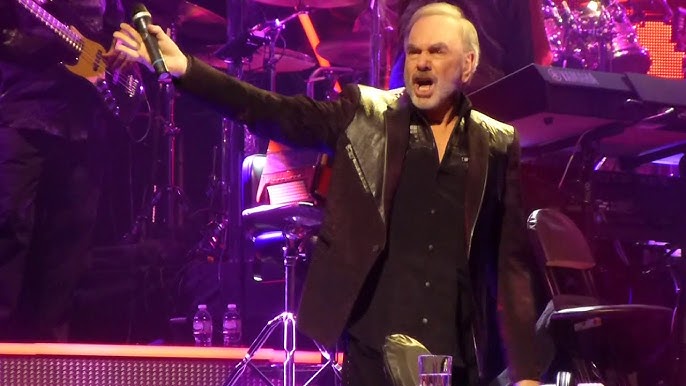The Encore of a Lifetime: How 40,000 Voices Became Neil Diamond’s Final Melody

The lights of Boston’s Fenway Park glowed with a nostalgic warmth, a massive, familiar embrace for the return of a legend. The atmosphere was already charged with emotion when the moment arrived: Neil Diamond, the man whose voice had soundtracked decades of American memories, was wheeled onto the stage.

At 84, the years of performing were etched onto his kind, smiling face. He sat in his wheelchair, trembling slightly but beaming at the sea of 40,000 devoted fans who instantly rose to their feet, their collective roar washing over the stadium.
This was not a concert; it was a pilgrimage. Since retiring from touring after his Parkinson’s diagnosis, appearances by the icon have been rare and deeply significant.
The Moment the World Took Over

The opening notes of his signature anthem, “Sweet Caroline,” began, and the stadium held its breath. Neil lifted the microphone, and his voice—that familiar, powerful baritone—filled the air, carrying the opening line: “Where it began, I can’t begin to knowing…”
But halfway through the second line, the voice that had carried millions through joy and sorrow cracked with emotion and strain. He paused, his eyes glistening, the physical effort too much to bear in that emotionally charged moment. A painful silence threatened to fall.

But it never had a chance.
The music didn’t stop. It grew louder. Stronger. Every single voice in that stadium became his own.
The collective sound was a magnificent, improvised choir—a spontaneous act of devotion from 40,000 souls who understood their hero was struggling, and they would carry him across the finish line.
Closer to Grace

When the iconic chorus finally hit, the stadium erupted in a thunderous wave of sound: “Sweet Caroline! Good times never seemed so good!”
The fans weren’t just singing; they were thanking him. They were shouting back every memory he had ever given them. “So good, so good, so good!” they roared in the famous call-and-response, a sound so powerful it transcended music.

From the stage, Neil’s eyes welled up. He was overwhelmed by the sheer, palpable force of that collective love. He leaned into the microphone, his voice now a quiet, tearful whisper, audible only because of the stadium’s brief, reverent pause. “You finished the song for me,” he said.
It was more than a performance; it was something closer to grace—a farewell carried on melody and light, a profound, shared moment of human connection. The artist, battling a debilitating condition, was supported entirely by the vast, pulsating heart of his audience.

As he waved one last time, slowly rolling backward from the spotlight, those 40,000 voices ensured the melody never faded. They made sure the silence never had a chance to fall.
The story of Neil Diamond and the Fenway faithful is a timeless testament to the power of emotion and the unbreakable bond between an artist and his audience. It proved that true connection doesn’t need perfection or flawless execution; it only needs heart, showing the world how music can heal, bind, and ultimately, ensure that a legend’s final song is the loudest one of all.